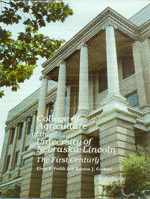Agriculture and Natural Resources, Institute of (IANR)
Date of this Version
1987
Abstract
Two major programs have been conducted by representatives of the private sector, College of Agriculture/ lANR administration and staff, and representatives of other public agencies primarily to: 1) identify how to enhance the economic performance of Nebraska agriculture, and 2) determine through specific recommendations what programs and facilities were needed in the College of Agriculture/lANR to accomplish the goals. The findings and recommendations of the first of these were published in STAR in 1976, and those of the second in 2001 Nebraska Agriculture in 1984. Important similarities and differences in the two programs, and in the publications emanating from each, are summarized in the table on the next page.
STAR had its origin in the early 70's, a concept that Dean Frolik promulgated after learning of a similar program underway at the University of Florida College of Agriculture. The program consisted of developing an inventory of the major segments of the state's agriculture, including both human and natural resources, of identifying trends, and of suggesting challenges for the future. Extension Director John L. Adams provided the primary leadership early in the program. However, as his health deteriorated, he was replaced in this role by Station Director Howard W. Ottoson.
At the time the STAR program was in its initial stages, the University Foundation was somewhat passive with respect to raising funds for the College. Although progress had been made by the private agricultural sector in supporting the College, such support had not crystallized to the extent that it has since. There was hesitancy on the part of College administrators to ask the private sector, especially farmers and ranchers, to devote very much of their time and personal expenses for travel to participate in conferences to develop programs aimed at strengthening financial support for the College. Hence, it is understandable that much of the effort in developing STAR was provided by IANR administrators and other College staff, and by representatives of other public agencies having an interest in agriculture.


Comments
From THE UNIVERSITY OF NEBRASKA-LINCOLN COLLEGE OF AGRICULTURE: The First Century by Elvin F. Frolik and Ralston J. Graham. Copyright © 1987 University of Nebraska Board of Regents.